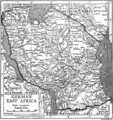German East Africa
German East Africa (GEA; German: Deutsch-Ostafrika) was a German colony in the African Great Lakes region, which included present-day Burundi, Rwanda, the Tanzania mainland, and the Kionga Triangle, a small region later incorporated into Mozambique. GEA's area was 994,996 km2 (384,170 sq mi),[2][3] which was nearly three times the area of present-day Germany and almost double the area of metropolitan Germany at the time.
German East AfricaDeutsch-Ostafrika (German)
Colony of Germany
Bagamoyo (1885–1890)
Dar es Salaam (1890–1916)
Tabora (1916, temporary)[1]
German (official)
Swahili, Arabic, Kirundi, Kinyarwanda, Maa, Kisukuma, Iraqw, Chaga languages
Islam, traditional African religion, Christianity (Catholic Church and Lutheranism)
27 February 1885
1 July 1890
21 October 1905
3 August 1914
25 November 1918
28 June 1919
995,000 km2 (384,000 sq mi)
7,700,000
The colony was organised when the German military was asked in the late 1880s to put down a revolt against the activities of the German East Africa Company. It ended with Imperial Germany's defeat in World War I. Ultimately the territory was divided amongst Britain, Belgium and Portugal, and was reorganised as a mandate of the League of Nations.
Education[edit]
Germany developed an educational program for Africans that included elementary, secondary, and vocational schools. "Instructor qualifications, curricula, textbooks, teaching materials, all met standards unmatched anywhere in tropical Africa."[23]: 21 In 1924, ten years after the beginning of the First World War and six years into British rule, the visiting American Phelps-Stokes Commission reported, "In regards to schools, the Germans have accomplished marvels. Some time must elapse before education attains the standard it had reached under the Germans."[23]: 21
The Swahili word for school, shule, is derived from the German word Schule.[25]
Population on the eve of World War I[edit]
In the most populous colony of the German Empire, there were more than 7.5 million locals. About 30% were Muslim and the remainder belonged to various tribal beliefs or Christian converts, compared to around 10,000 Europeans, who resided mainly in coastal locations and official residences. In 1913, only 882 German farmers and planters lived in the colony. Approximately 70,000 Africans worked on the plantations of GEA.[26]
Break-up of the colony[edit]
The Supreme Council of the 1919 Paris Peace Conference awarded all of German East Africa (GEA) to Britain on 7 May 1919, over the strenuous objections of Belgium.[31]: 240 The British colonial secretary, Alfred Milner, and Belgium's minister plenipotentiary to the conference, Pierre Orts, then negotiated the Anglo-Belgian agreement of 30 May 1919[32]: 618–9 where Britain ceded the north-western GEA districts of Ruanda and Urundi to Belgium.[31]: 246 The conference's Commission on Mandates ratified this agreement on 16 July 1919.[31]: 246–7 The Supreme Council accepted the agreement on 7 August 1919.[32]: 612–3
On 12 July 1919, the Commission on Mandates agreed that the small Kionga Triangle south of the Rovuma River would be given to Portugal;[31]: 243 it eventually became part of independent Mozambique. The commission reasoned that Germany had virtually forced Portugal to cede the triangle in 1894.[31]: 243
The Treaty of Versailles was signed on 28 June 1919, although the treaty did not take effect until 10 January 1920. On that date, the GEA was transferred officially to Britain, Belgium, and Portugal. Also on the same day, "Tanganyika" became the name of the British territory.
Some names in German East Africa continued to bear German spellings of the local names for a while, such as "Udjidji" for Ujiji and "Kilimandscharo" for Mount Kilimanjaro, "Kleinaruscha" for Arusha-Chini and "Neu-Moschi" for the city now known as Moshi. (Kigoma was known for a time as "Rutschugi".)[33]
Many places were given African names or had their previous names reestablished:[34][35][36][37]









